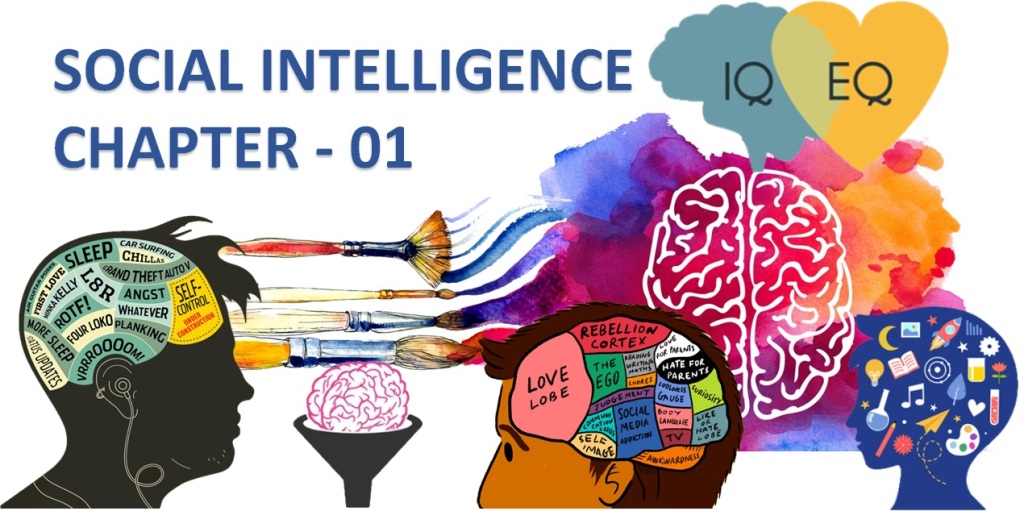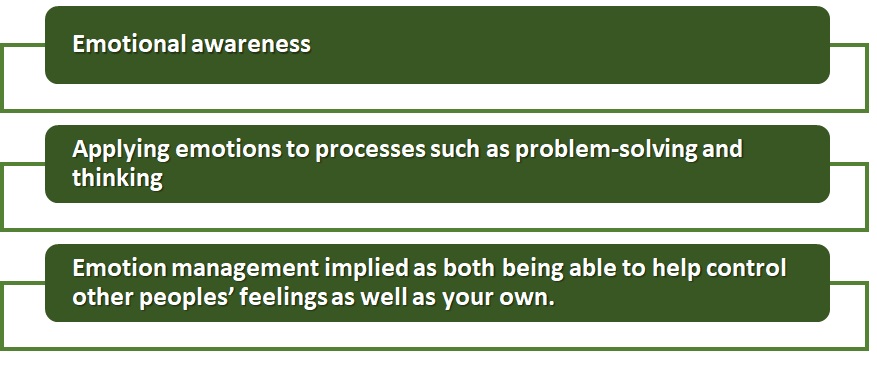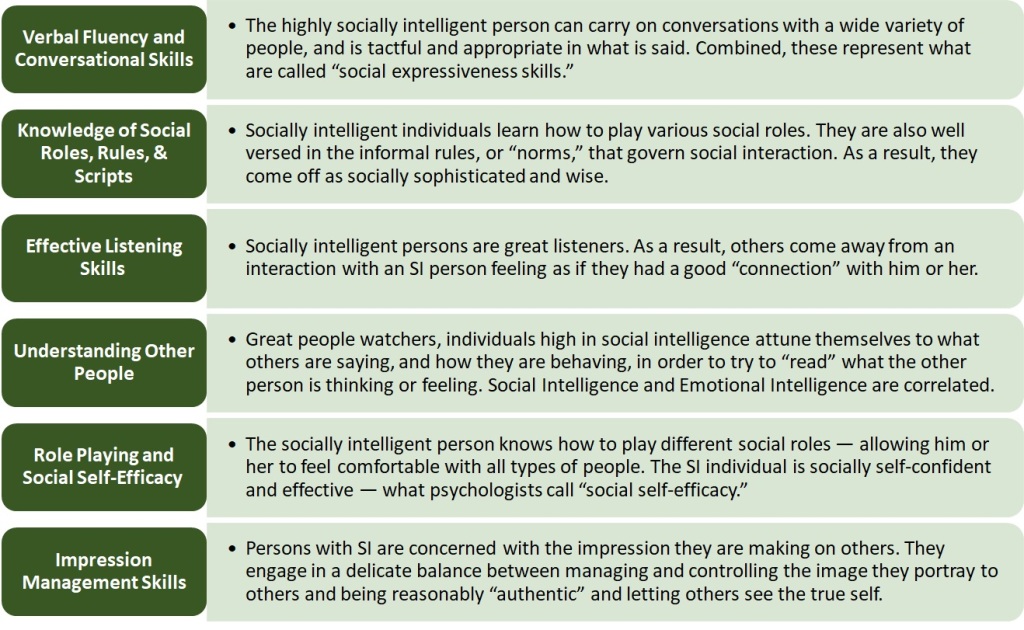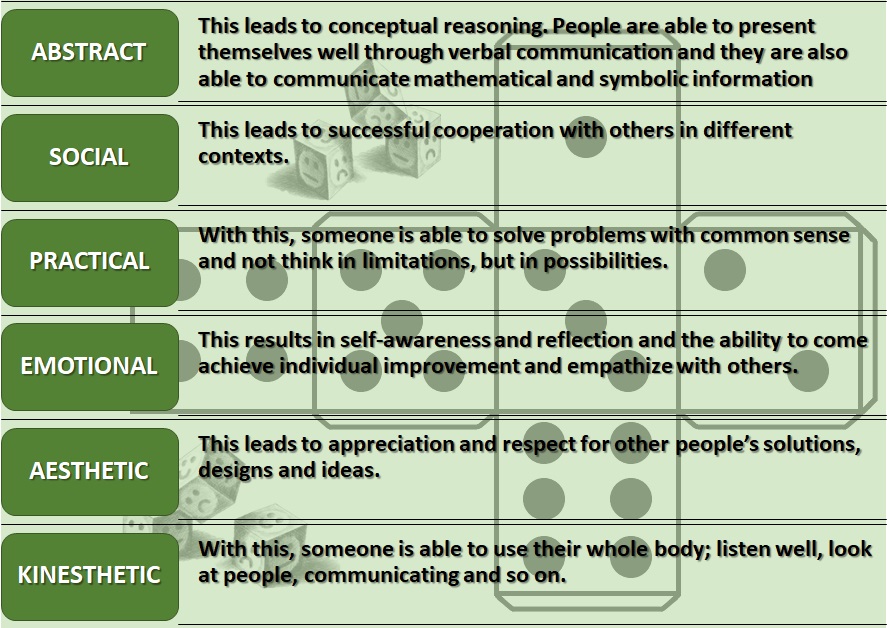– CHAPTER 01

Social intelligence is the ability to understand and navigate social situations effectively. It involves the ability to read and interpret social cues, manage emotions, communicate effectively, and build and maintain relationships. Social intelligence has been linked to a range of positive outcomes, including improved job performance, better health outcomes, and more satisfying relationships.
Intelligence
According to Psychology Today, intelligence is “…a construct that includes problem solving abilities, spatial manipulation and language acquisition.” Intelligence measured by IQ tests isn’t the be all and end all. Regardless of the number of languages that we learn to speak, the amount of information we memorize, and even how well we can complete math problems, intelligence inevitably is a more complex measure.
There are three types of intelligence, two of which are unmeasurable in IQ tests, and are pivotal for success in leadership levels in business, and even in innovation. Of these, Emotional Intelligence (EQ) and Social Intelligence (SQ) are unmeasurable. Lets see what each of these mean and their impact. People that have higher EQ and SQ tend to go farther in life than those with high IQ but low EQ and SQ. Most schools capitalize in improving IQ level while EQ and SQ are played down. A man of high IQ can end up being employed by a man of high EQ and SQ even though he has an average IQ. The EQ represents our character; the SQ represents our fame. EQ and SQ make one manage better than the other.

Now there is a forth one: The Adversity Quotient (AQ). This makes people go through a rough patch in life and come out without losing their centers. The AQ determines who will give up in face of troubles, who will abandon their family or who will consider suicide.
Emotional Intelligence
In contrast to SQ, Psychology Today Journal describes emotional intelligence as “…the ability to identify and manage your own emotions and the emotions of others.” Emotional intelligence contains three competencies:

When EQ and IQ come together, they form ESI, or Emotional and Social Intelligence. ESI competencies are those linked to self-awareness, self-management and relationship management, which enable people to understand and manage their own and others’ emotions in social interactions. ESI competencies, rather than IQ and technical ones, are responsible for the gap between the performance of those leaders that are great from those just deemed average. Fortunately, while IQ often gets set in stone early on in life, ESI competencies can be learned and improved over time.
Both skillsets are critical for embracing innovation. Social intelligence is more about the future. Social intelligence came about so that people could survive, and it’s about figuring out the best way for us to get along, and come out of a situation with a favorable outcome. Even if we have the qualifications on paper, a lack of social intelligence could lead to strained or ruined relationships, as well as lost opportunities.
In contrast, emotional intelligence is more about the present, and more closely related to emotions and feelings. By reading someone’s face, we can tell whether that person is happy, incredibly nervous before going into a job interview, or shy because that person happens to be in his/ her own corner in the middle of a party.
Social Intelligence
Psychology Today Journal states that social intelligence develops from experience with people and learning from success and failures in social settings. Some key elements of social intelligence may be-

In 2003, the American psychologist Karl Albrecht defined Social Intelligence (SI) as the characteristic of employees and supervisors to be able to interact well with others and achieve full cooperation. It is about interpersonal skills and the behavior people display toward each other. This behavior can have a ‘toxic’ effect and a ‘nurturing’ effect.
First, it is about the sensitivity to and insight into the needs and interests of others; this is called a social radar. Being aware of certain situations and knowing how to act are part of that.
To a certain extent, Social Intelligence is also focused on self-assessment and reflection and becoming aware of one’s own observations and response patterns. With that, Social Intelligence, offers the opportunity to effectively deal with complex social relations and/ or environments and negotiate. Most importantly, they take care of the impression of themselves they exude on other people. This requires a delicate balance between managing and controlling the image you portray to others and being reasonably “authentic” and letting others see the true self.
The Social Intelligence Philosophy
True intelligence is about both book smarts and street smarts. Social Intelligence (SI) is the ability to successfully build relationships and navigate social environments. Our society puts a huge emphasis on book smarts and IQ, but our relationships effect a much bigger part of our lives.
Strong relationships improve our immune system and help combat disease. Loneliness and weak relationships are one of the major sources of stress, health problems and depression. Our relationships affect every area of our lives–from colleagues to spouses to friends to kids.

We are wired to connect. We have specific structures in our brain built to optimize relationships. A spindle cell is the fastest acting neuron in our brain that guides our social decisions. Human brains contain more of these spindle cells than any other species.
Mirror neurons help us predict the behavior of people around us by subconsciously mimicking their movements. This helps us feel as they feel, move as they move.
Social Intelligence (and Emotional Intelligence) at the Workplace
One of the greatest advantages of developing social and emotional intelligence in the workplace is the ability to read between the lines. To know when someone is content, upset, challenged, or emotionally healthy allows us to find the best ways to engage and work with them. When peers feel that their feelings are being understood and taken into account, they can communicate more openly. This can be invaluable for learning where the work environment needs to improve, and where others feel satisfied.
In the workplace, most people don’t want to upset the applecart. But just because our associate accepted a task doesn’t necessarily mean they have any passion for it, or even that they are the ideal person for the job. By learning how to read the emotional and social cues of the team members, we can establish their strengths, where they could stand to improve, and how well they synergize with the rest of the team.
Utilizing Social and Emotional Intelligence in the Workplace

Social Intelligence & Nurturing Behaviour
Toxic behavior leads to people feeling angry, frustrated, guilty or other negative and inadequate emotions. Nurturing behavior on the other hand, makes people feel appreciated, respected, competent and motivated. That is the foundation of Social Intelligence. The more someone is subjected to a continuing pattern of toxic behavior, the lower his level of Social Intelligence will be and the less able he will be to connect people to each other and influence them effectively. A continuing pattern of nurturing behavior will lead to a higher degree of effective interaction with others.
Six Dimensions: Compare these dimensions to the six sides of a dice; each side plays an equal part and is therefore proportional to the other sides. Each side represents a dimension and together all six make up the total competency that is necessary for social intelligence:

Indicators of Social Intelligence
While we want to be able to engage with people in a mutually comfortable way, we should not have to sacrifice genuine expression in favor of a polite nod or gracious smile. The two are not mutually exclusive. People who are socially intelligent function in such a way that they can communicate with others and leave them feeling at ease without sacrificing who they are and what they want to say. Some core traits may be:

***To be continued in Chapter 02 (Attributes, Building Social Intelligence, Social Intelligence Profile, Fostering Social Intelligence, )
Link to Chapter – 02:

Content Curated By: Dr Shoury Kuttappa

